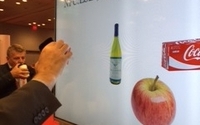Commentary
In-Screen NFC-TV Coming for Your Reach
- by Chuck Martin , Staff Writer, January 14, 2014
 Get ready for NFC-TV.
Get ready for NFC-TV.
No, not in your home, but in a store, at an airport or in your local mall.
Now adding to such information and engagement triggers as QR code and Augmented Reality comes in-screen NFC.
At the National Retail Federation’s annual conference at the Javits Center in New York yesterday, I saw a large TV with near field communication sensors built into the screen.
The NFC monitor systems already have been sold in Singapore, France and Italy, according to
Vincent Berge, CEO of Think & Go.
Berge demonstrated the system for me at “Retail’s Big Show 2014,” though following the 150,000-people attended International CES in Las Vegas last week, the show seemed quite manageable.
The company embeds NFC sensors inside the TV screen. The one I saw had six sensors, but Berge says they have included as many as 22 in one screen. I asked him how they determine how many should be embedded.
“We started with two, then went to four and then to six, which seems like the best number for most applications,” said Berge.
Though NFC has been used to trigger various things like bus and train schedules, placing multiple NFC sensors inside a monitor falls on the novel side.
In one of the demonstrations, the screen displayed products including wine, an apple and Coca-Cola.
A consumer with an NFC-enabled phone – about 500 million are expected to be shipped this year – taps the phone over a desired product, which triggers information about that product that is sent instantly to the smartphone. The consumer then can directly purchase the items from their phone.
And then the trail begins. If the consumer buys a product, additional offers and coupons associated are automatically triggered and sent to the opted-in consumer.
The two screens of the TV and smartphone are intimately linked so that if a product is clicked, the behavior is stored for later use.
An airport traveler can touch a phone to a screen displaying flight times and touch only their particular flight. Targeted messages then can be sent to the traveler’s phone, such as suggesting a nearby café, with a coupon to sweeten the deal.
Berg said the company is working on embedding Apple iBeacon technology into screens, since the system currently requires NFC phones, which excludes iPhones.
What struck me is how the two screens become tightly integrated during an interacting process.
In one demonstration a video plays and touching the phone to what a person is wearing instantly brings that product to the smartphone, with all associated purchasing information and capability.
Two-way information transfer is starting to get a little more interesting.



